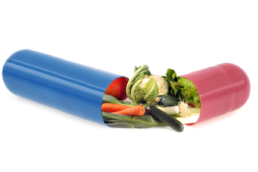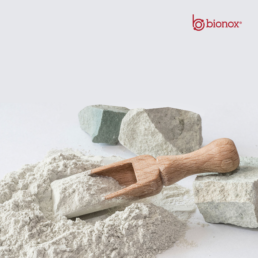Detoxing Microplastics, Metal, and Vaccine contamination
Detoxing any time soon? The growing concern surrounding microplastics, metal contamination, and vaccine contamination is pushing people to find effective ways to protect themselves from these potential hazards. This article will explore various natural ingredients known for their detoxifying and health-supporting properties. These ingredients can help rid the body of unwanted toxins and heavy metals, support immune system function, and maintain overall health.
Natural Chelators and Detoxifiers
EDTA (Ethylenediaminetetraacetic Acid): EDTA is a synthetic amino acid that has ben shown to effectively bind to heavy metals in studies, such as lead, mercury, and cadmium, and helps remove them from the body.
EDTA chelation therapy has been used to treat heavy metal poisoning, cardiovascular disease, and other health conditions related to toxic metal buildup. It has been shown to have an impact on Nitric Oxide Synthase production, health and other important factors.
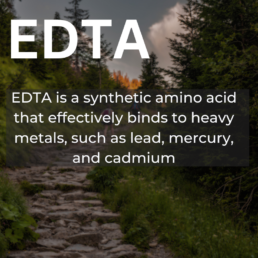
Chlorella Algae: Chlorella is a type of single-celled green algae known for its detoxifying properties. It is rich in chlorophyll, which binds to heavy metals and helps remove them from the body. Additionally, Chlorella supports the immune system, aids digestion, and promotes overall well-being.
EDTA Is A Natural Ingredient
Since it is a natural ingredient, using it daily in a chelation therapy supplement is a no brainer, as it has no downside. It has nutritional value, other benefits for your health, too many to get into, and is an easy and affordable means to support your nitric oxide synthase pathways.
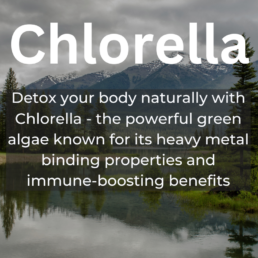
Modified Citrus Pectin: Modified Citrus Pectin (MCP)
MCP is a soluble fiber derived from citrus fruits. It has been shown to bind to heavy metals, such as lead and mercury, and help remove them from the body. MCP also supports digestive health, helps maintain healthy cholesterol levels, and has potential anti-cancer properties according to some studies.
Several studies and reviews have indicated that Modified Citrus Pectin (MCP) may have anti-cancer properties. Here are some key findings from various sources:
- General Potental Anti-Cancer Properties: MCP is recognized as a dietary supplement with potential in oncology. It has shown abilities in anti-cancer, anti-metastases, immune-boosting, and heavy metal detoxification. Specifically, MCP blocks Galactin-3, an important inflammatory compound, and may enhance the effectiveness of chemotherapy drugs. Research suggests that MCP can help reduce metastases in prostate and other cancers, reducing the proliferation of cancer cells both in vitro (in test tubes) and in vivo (in living organisms).
- Therapeutic Agent for Various Conditions: MCP, derived from citrus peels, is recommended as a therapeutic agent not only for immune support but also possibly for for cancer, heavy metal toxicity, and fibrotic diseases. This indicates a broad spectrum of potential health benefits, including its potential role in cancer therapy.
- Inhibitory Effect on Liver Metastases: In a study focusing on a mouse colon cancer model, modified citrus pectin demonstrated an inhibitory effect on liver metastases. This suggests its potential effectiveness in reducing the spread of cancer to the liver from other areas.
- Beneficial Effects on Colon and Breast Cancer: Data suggest that MCP, specifically, is beneficial in the development and spread of malignancies, particularly in colon and breast cancer. This further adds to its profile as a bioactive food polysaccharide with potential cancer-preventive properties.
- Chemopreventive and Antitumoral Activities: Both pectin and pH- or heat-modified pectin have shown chemopreventive and antitumoral activities against some aggressive and recurrent cancers. This review focuses on how these forms of pectin display these activities and explores the possible underlying mechanisms.
MCP Has Immune Modulating Effects
These studies and reviews highlight the growing interest in MCP as a natural substance with potential anti-cancer properties. While more research is needed to fully understand its mechanisms and efficacy in humans, the current findings are promising and suggest a potential role for MCP in cancer prevention and treatment. We are in no way saying that this is a cure, or our product can cure or have any effect on cancer. Our goal is to merely point out the research, possible implications and health benefits.
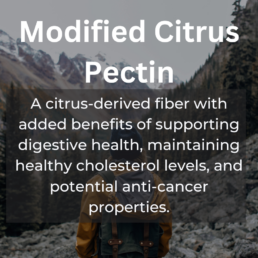
Leaf Extract : Cilantro
Cilantro a popular culinary herb, contains compounds that bind to heavy metals and facilitate their removal from the body. The Cilantro leaf’s extract has been used as a natural chelator to support detoxification processes, particularly for mercury and lead.
-
Detoxification
Cilantro is known for its potential detoxifying effects, particularly those related to removing heavy metals from the mammalian / human body. Compounds that are commonly found in cilantro may bind to common toxic metals like lead, arsenic, and mercury, aiding in their elimination from the body via natural means.
-
Antioxidant Properties
Cilantro contains powerful and useful antioxidants, which can help protect the body against damage from free radicals, nasty little things that you for sure do not want! These antioxidants include quercetin, tocopherols, and terpenoids, which contribute to reducing oxidative stress and may help prevent certain chronic diseases and can also help extend the life of nitric oxide, an important nutrient/chemical vital for cardiovascular health!
-
Anti-inflammatory Effects
Cilantro has been found to have anti-inflammatory properties. Chronic inflammation is a root cause of many health conditions, if not most of today’s biggest diseases, so consuming foods with anti-inflammatory properties like cilantro can be beneficial for overall health and common sense disease prevention.
-
Digestive Health
Cilantro can aid in digestion and may help in settling an upset stomach. It has been used traditionally for its digestive benefits, helping with indigestion, flatulence, and bloating.
-
Antimicrobial Properties
Some studies suggest that cilantro has antimicrobial properties, meaning it can help fight against certain bacteria and fungi. This can be beneficial in preventing foodborne illnesses when cilantro is used in cooking.
-
Heart Health
Cilantro may have a positive effect on heart health. It can help lower bad cholesterol (LDL) levels and increase good cholesterol (HDL). Also, its antioxidants may help in preventing damage to the heart and blood vessels.
-
Blood Sugar Regulation
There is some evidence that cilantro may help in managing blood sugar levels, making it a potentially beneficial herb for people with or at risk of diabetes.
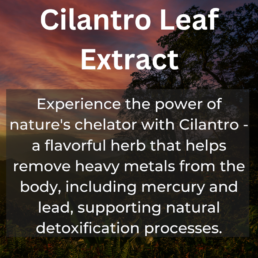
Shilajit Extract: Shilajit is a natural resinous substance found in the Himalayan mountains. It is rich in fulvic acid, a powerful detoxifying agent that binds to heavy metals and other environmental toxins, helping to remove them from the body. Shilajit also supports energy production, cognitive function, and overall vitality.

Immune System and Liver Support & Detoxing
Amazing Zeolite
Zeolite is a group of microporous minerals with a unique cage-like structure, which allows it to trap and remove heavy metals and other toxins from the body. Zeolite has been used to support detoxification, improve immune function, and promote overall health.
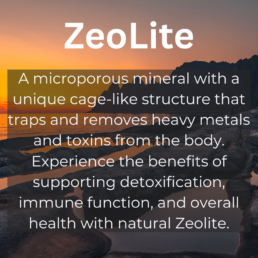
Glutathion & NAC
Glutathione is a powerful antioxidant that is crucial in detoxification and immune system function. The Glutathione Precursor Support Blend provides the necessary amino acids (glutamic acid, cysteine, and glycine) to help the body produce glutathione, thus supporting detoxification and immune health.
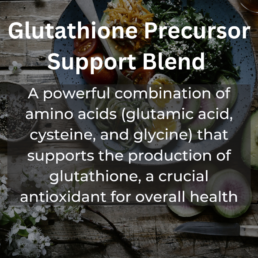
Alpha Lipoic Acid: Alpha Lipoic Acid
(ALA) is a potent antioxidant that helps neutralize free radicals and supports the body’s natural detoxification processes. ALA also assists in regenerating other antioxidants, such as vitamin C and glutathione, further enhancing the body’s defense against toxins and oxidative stress.
Uva Ursi Leaf Powder
Uva Ursi is an herbal remedy with a long history of use for its diuretic and urinary tract health-supporting properties. It is also believed to help remove toxins and heavy metals from the body through increased urine production.
Milk Thistle Seed Powder
Milk Thistle is a well-known herb that supports liver health and detoxification. Its active compound, silymarin, has been shown to protect liver cells from damage and promote the regeneration of damaged liver tissue. Milk Thistle can help the body effectively process and eliminate toxins and heavy metals by supporting liver function.
Supporting the Detoxification Process
Cellulose Capsule: Cellulose capsules are a plant-based alternative to traditional gelatin capsules, providing a suitable option for vegetarians and vegans. These capsules can protect sensitive ingredients from stomach acid, ensuring their release in the small intestine for maximum absorption and effectiveness.
Conclusion
As concerns about microplastics, metal contamination, and vaccine contamination continue to rise, incorporating natural detoxifying ingredients into one’s daily routine can help support the body’s natural ability to eliminate toxins and heavy metals. The combination of chelators, immune system supporters, and liver-supporting ingredients discussed in this article can provide a comprehensive approach to maintaining overall health and well-being in the face of environmental challenges.
How To Boost The Nitrates in Beetroot & Vegetables
How can you boost the nitrates in beetroot and vegetables, and why should you care? Let’s dive right in and find out!
Understanding Nitrates in Beetroots & Veggies
Nitrates are essential chemical and nutritional components in plants, especially in beetroots and arugula, both contributing significantly to their nutritional and health-promoting profile.
In the body, nitrates from beetroots and other veggies like arugula are converted into nitric oxide, which plays a crucial role in cardiovascular health, immune health, and brain function and is known for lowering blood pressure and improving blood flow.
There are literally thousands of studies on the benefits of nitric oxide from many sources like arginine, citrulline, and beetroot. If you like to garden, it makes a lot of sense to learn how you can increase the amount of nitrate in your food since it offers so many incredible health benefits.
Beetroot & Nitrates

High Nitrate Veggies
Arugula (Rocket)
Arugula is renowned for its very high nitrate levels, making it one of the top vegetables in this category.
Ideal Growing Conditions: Arugula prefers moderate to cool climates. It is versatile and can be grown in various regions across the United States, especially those with mild winters.
Beetroot
Beetroots are well-known for their substantial nitrate content, which benefits health.
Ideal Growing Conditions: Beetroots grow best in cooler climates. They are adaptable and can thrive in many areas across the U.S., particularly in regions with temperate climates.
Celery
Celery is another vegetable with a high concentration of nitrates, alongside being a low-calorie and high-water-content vegetable.
Ideal Growing Conditions: Celery requires a long growing season and consistent moisture. It grows well in regions with steady temperatures and ample water supply, which can be found in various parts of the United States.
These vegetables, with their high nitrate content, have diverse growing requirements, so almost anyone reading this article should be able to grow at least one of these.
Arugula’s ability to adapt to a range of climates, beetroots’ preference for cooler temperatures, and celery’s need for a consistent, moist environment illustrate the variety of conditions needed to grow and cultivate these nutrient-rich vegetables successfully.
To enhance the nitrate content in vegetables such as arugula, beetroot, and celery, it’s essential to focus on effective soil management and various fertilization techniques.
Here’s an integrated approach to increasing the nitrate content in your garden produce, aiming to boost overall health benefits:
Nitrogen-Rich Fertilization
Select fertilizers high in nitrogen since nitrates are a form of nitrogen absorbed by plants. Options like calcium nitrate, potassium nitrate, or ammonium nitrate are effective. Organic alternatives such as blood meal or fish emulsion, also rich in nitrogen, can be used. It’s important to apply these fertilizers regularly as per the manufacturer’s guidelines. Leafy greens like arugula might require more frequent applications to maintain high nitrate levels and support rapid growth.
Soil Management
Regular soil testing is a key step in monitoring nitrate levels, allowing you to adjust your fertilization strategy effectively. Nitrates are crucial for healthy plant growth, and understanding their levels in your soil is fundamental.
Maintaining a soil pH between 6.0 and 7.0 helps maximize nitrogen availability for most vegetables. Adding organic matter such as compost or well-rotted manure improves soil structure and microbial activity, aiding in converting organic nitrogen sources to nitrates.
Irrigation Practices
Consistent watering is vital, as water stress can affect a plant’s ability to absorb nitrates. However, it’s equally important to avoid overwatering, which can cause the leaching of nitrates from the soil, reducing their availability to plants.
Crop Rotation
Incorporating nitrogen-fixing crops like legumes in your crop rotation can enhance the nitrogen content of the soil for the subsequent growing season, benefiting the next crop in terms of nitrate availability.
Harvest Timing
Harvesting your vegetables at the right time is crucial. Younger arugula leaves or medium-sized beetroots often have higher nitrate concentrations than over-matured ones. Since commercial farms are interested in larger-size veggies as they sell for more money, this is yet another reason why growing your own is advisable.
Mulching
Applying organic mulch around the plants is beneficial. Mulch helps maintain soil moisture and temperature, fostering better absorption of nitrates by the plants.
Controlled Environment Growing
Consider using controlled environments such as hydroponic systems or greenhouses. These settings allow for precise control of nutrient levels, including nitrogen, which can lead to higher nitrate concentrations in the plants.
By adopting these strategies, you can effectively increase the nitrate content in vegetables like arugula, beetroot, and celery, enhancing their nutritional value and contributing to a healthier diet.
Arugula Can Be Very High In Nitrates

Unraveling the Best Nitric Oxide Boosters
What are the best nitric oxide boosters? The quest for optimal health often leads us to natural solutions like Arginine and beets, both known for their ability to boost nitric oxide levels. In this comprehensive exploration, we delve into the science behind these two powerhouses, evaluating their effectiveness and understanding the role of nitric oxide in the human body and to understand what are the best nitric oxide boosters.
The Nitric Oxide Story
Nitric oxide, a simple molecule with immense biological importance, plays a critical role in various bodily functions. It’s primarily produced in the cardiovascular and nervous systems and acts as a neurotransmitter. The molecule gained significant attention after being named the “Molecule of the Year” in 1992 and has been the subject of over 140,000 studies, leading to numerous pharmaceutical developments like Viagra.
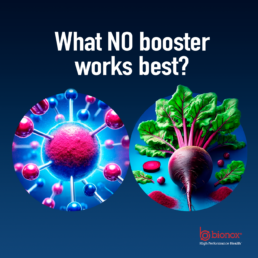
Arginine: The Traditional Nitric Oxide Booster
Arginine, a semi-essential amino acid, has long been the focal point in nitric oxide research. The body naturally produces Arginine, which is also found in various foods. It transforms into nitric oxide through an enzyme called nitric oxide synthase, present in the endothelium of arteries. However, the effectiveness of Arginine supplementation has been debated, especially concerning its conversion rate into nitric oxide in older individuals. Despite these discussions, Arginine’s role in boosting nitric oxide remains substantiated by extensive research and clinical practice.
Beets: The Emerging Nitric Oxide Source
Beets, and other nitrate-rich foods like arugula and spinach, represent an alternative pathway for nitric oxide production. Some people who have products to sell are saying that only beets rank among the best nitric oxide boosters.
The nitrates in these foods convert into nitric oxide through a process involving oral microbiome and stomach acid, independent of the nitric oxide synthase pathway. This feature makes them particularly beneficial for individuals with endothelial dysfunction. However, sourcing quality nitrate-rich supplements can be challenging, and factors like oral microbiome health and stomach acid levels significantly influence their effectiveness.
Comparing Arginine and Beets
When comparing arginine and beets, each has its advantages and drawbacks. Arginine’s benefits are well-researched, and it’s naturally produced by the body and it is well known as one of the best nitric oxide boosters around. However, it may not be as effective in older individuals due to decreased nitric oxide synthase activity. On the other hand, beets offer a nitric oxide synthase-independent pathway but rely heavily on the individual’s oral and gut health for conversion.
Practical Applications and Products
In clinical practice, understanding each patient’s unique health profile is crucial when choosing between Arginine and beets. For those with compromised nitric oxide synthase activity or seeking a natural alternative, beets and other nitrate-rich foods can be an excellent choice. Conversely, Arginine supplements, often combined with other co-factors and antioxidants, can offer a more controlled and research-backed approach.
Several products on the market cater to these needs, ranging from Arginine-based supplements to beetroot extracts and greens powders high in nitrates. Additionally, testing methods like saliva nitrate strips and digital pulse wave analyzers can help track nitric oxide levels and arterial health, guiding supplementation choices.
Poorly Designed Studies
The Vascular Interaction With Age in Myocardial Infarction (VINTAGE MI) clinical trial, a notable study on the use of L-arginine in acute myocardial infarction patients, has sparked considerable debate in the medical community. This study, published in the January 2006 issue of the Journal of the American Medical Association (JAMA), sought to determine if adding L-arginine to standard post-heart attack therapy could reduce vascular stiffness and improve heart function over a six-month period.
Study Design and Findings
- Context & Objective: Recognizing L-arginine as a substrate for nitric oxide synthase and its potential to reduce vascular stiffness, the study aimed to assess its efficacy in improving cardiac function post-heart attack.
- Methodology: It was a single-center, randomized, double-blind, placebo-controlled trial, enrolling 153 patients who had experienced a first ST-segment elevation myocardial infarction. The participants were randomized to receive either L-arginine (goal dose of 3 g three times a day) or a placebo for six months.
- Results: The study found no significant improvement in vascular stiffness or left ventricular ejection fraction in the L-arginine group compared to the placebo group. Notably, six participants (8.6%) in the L-arginine group died during the study, while no deaths were reported in the placebo group. This led to safety concerns and the early closure of the trial by the data and safety monitoring committee.
Criticisms and Controversies
The VINTAGE MI trial has been criticized for several reasons:
- Dosage and Administration: Some experts argue that the dosage of L-arginine used was inadequate for therapeutic effects. Furthermore, questions have been raised about the absorption and metabolism of L-arginine in the patients enrolled in the study.
- Patient Selection: Concerns have been raised regarding the specific cohort of patients chosen for the study, particularly their health status and how representative they were of the general population experiencing heart attacks.
- Study Design: Critics have pointed out potential flaws in the study’s design, including the single-center nature of the trial and the methods used to measure outcomes such as vascular stiffness and heart function.
Implications for Clinical Practice
While the VINTAGE MI trial suggests potential risks associated with L-arginine supplementation post-heart attack, it is important to consider these results within the broader context of L-arginine research and cardiovascular health. The role of L-arginine in cardiovascular therapy, particularly in non-post-infarction contexts, continues to be supported by a body of research indicating its benefits in vascular health and nitric oxide production.
The VINTAGE MI trial represents a critical piece of research in the ongoing evaluation of L-arginine’s role in heart health. However, its findings should be interpreted with caution and in conjunction with other studies. As with any supplement or medication, the suitability of L-arginine for individual patients should be assessed based on a comprehensive understanding of their overall health, the specific health condition being treated, and the broader scientific evidence available.
In the debate between Arginine and beets for nitric oxide boosting, there’s no one-size-fits-all answer. Each has its unique benefits and limitations. The choice largely depends on individual health factors, goals, and preferences. Doing a good heavy metal detox is going to be very helpful in any case, no matter what you take.
By understanding the nuances of these nitric oxide boosters, one can make informed decisions to optimize health and wellness.
If you would like in depth information watch my video presentation from ANMA below.
10 Reasons Why Beetroot is Bad for Your Health

At first glance, the question why beetroot is bad for your health seems to challenge everything you know about or have heard about this nutritionally dense super-food.
However, there are caveats we need to consider. It is not always good, not always effective, and not always from a good source. Let’s dive into why beetroot is bad for your health or, better phrased, why it could be bad in some instances!
10 Reasons Why Beetroot Is Bad For Your Health
Reason #1
1. Diabetes and Blood Sugar Management:
Individuals with diabetes may need to limit beetroot intake due to its sugar content. If you take a cheap beetroot powder, it’s probably only filler. Full of sugar, and it’s only purpose is to take your money and turn your poop red.
Lesson: Get beetroot with guaranteed nitrate amounts and low-sugar.
Reason #2
2. Pre-existing Kidney Stones:
Some beetroot is high in oxalates, which can contribute to kidney stone formation in susceptible individuals. Oxalates, or oxalic acid, are naturally occurring compounds found in many commonly consumed plants, including beetroot.
In certain susceptible individuals, particularly those with a tendency to form kidney stones, oxalates can bind with calcium. This take place in the urine and forms calcium oxalate kidney stones. These are the most common type of kidney stones.
High levels of oxalates can also interfere with the absorption of certain minerals, leading to deficiencies. For most people, dietary oxalates are not a problem, but for those at risk of kidney stones or with certain health conditions, it’s often recommended to limit oxalate intake.
Lesson: Get a pure beetroot with NO OXALATES
Reason #3
3. Compromised Immune Systems:
Beetroots from sources without proper sanitary controls could harbor pathogens, posing a risk to those with weakened immune systems.
Individuals with compromised immune systems, such as those undergoing chemotherapy, who are living with HIV/AIDS, or who may be taking immunosuppressive medications, need to be particularly cautious about the foods they consume.
Their bodies are less equipped to fight off infections, which means that consuming produce that has not been properly cleaned or that comes from sources with inadequate sanitation can pose serious health risks.
Beetroots, like any raw vegetables, can carry bacteria, viruses, or parasites if they are not grown, harvested, stored, and prepared safely. This can include common foodborne pathogens like E. coli, Salmonella, and Listeria, which can lead to severe illness in immunocompromised individuals.
These individuals should ensure that any beetroot they consume is from a reliable source, thoroughly washed, and cooked if necessary to reduce the risk of foodborne illness. For most it makes more sense to purchase a refined and standardized beetroot supplement.
Reason #4
4. Medication Interference:
Beetroot may interact with certain medications, such as blood thinners, due to its vitamin K content.
Beetroot contains some vitamin K, which plays a key role in blood clotting. For individuals taking blood-thinning medications like warfarin, consistent vitamin K intake is crucial because fluctuations can affect the medication’s effectiveness.
A sudden increase in vitamin K can lessen the blood-thinning effect, potentially leading to clot formation, while a decrease can enhance the effect of the medication, increasing the risk of bleeding.
Therefore, it’s important for individuals on such medications to maintain a steady intake of vitamin K and to consult with their healthcare provider before making dietary changes that include foods like beetroot, which has a higher vitamin K content.
Lesson: Work closely with your healthcare provider if you are on any of these medications.
Reason #5
5. Blood Pressure Fluctuations:
For those with low blood pressure, the blood-pressure-lowering effect of beetroot could potentially cause issues. Beetroot contains dietary nitrates, which the body converts into nitric oxide, a molecule that dilates blood vessels and can lower blood pressure. This is generally beneficial for those with high blood pressure; however, it can be problematic for individuals with hypotension (low blood pressure). For these individuals, consuming beetroot could further lower their blood pressure, leading to symptoms like dizziness, fainting, and blurred vision.
It’s essential for people with low blood pressure to consult with a healthcare provider before adding high-nitrate foods like beetroot to their diet to avoid exacerbating their condition.
Lesson: Take beetroot to lower your blood pressure if it is high!
Reason #6
6. Irritable Bowel Syndrome (IBS):
The high fiber content in beetroot can exacerbate symptoms in individuals with IBS. Beetroot is high in fiber, which is generally considered beneficial for digestive health for most people. However, for individuals with Irritable Bowel Syndrome, high-fiber foods can sometimes trigger symptoms such as abdominal pain, bloating, and altered bowel habits (either constipation or diarrhea).
The reason for this is that the digestive system of someone with IBS might be sensitive to certain types of fiber or to the increased bulk and gas production that comes with fiber intake. Therefore, it’s advisable for Irritable Bowel Syndrome sufferers to introduce high-fiber foods like beetroot slowly and in small amounts and to consult with a dietitian or doctor to manage their condition effectively.
Lesson: Use caution if you have IBS.
Reason #7
7. Non-Standardized Nitrate Levels: Without standardized nitrate levels, beetroot products may not provide consistent health benefits. Beetroot’s health benefits are largely attributed to its nitrate content, which the body converts into nitric oxide, a compound that aids in blood vessel dilation circulation and improves blood flow to organs, the brain, and skin, as well as the heart.
However, there is a big problem: the nitrate content in beetroot can vary widely depending on the soil quality, the beetroot variety, and farming practices. Non-standardized nitrate levels mean that the consumer cannot always be sure of the amount of nitrate they are ingesting with each serving, which can lead to inconsistent health benefits.
For those of us seeking the cardiovascular benefits of nitrates, standardized levels are important to ensure they are consuming an effective and safe amount.
Lesson: Buy beetroot with standardized nitrates!
Reason #8
8. Insufficient Intake:
Not consuming an adequate amount of beetroot and its associated nitrates may result in no significant health benefits. For beetroot to confer its cardiovascular and endurance benefits, it needs to be consumed in amounts that provide a sufficient dose of its active compounds, particularly nitrates. At a minimum each dose should have at least 100mg of nitrates to have any effect.
If an individual consumes beetroot in very small quantities, the intake of these beneficial compounds may not be enough to make a significant impact on health. It’s similar to taking a medicine in a dose that’s too low to be effective; you won’t see the desired results. Therefore, understanding the appropriate serving size is key to reaping the potential health benefits that beetroot can offer.
Lesson: Take a high quality beetroot product, that clearly shows what is in it!
Reason #9
9. Excessive Intake: Conversely, too much beetroot can lead to an overload of nitrates and potential health concerns. While beetroot is beneficial, excessive consumption can lead to an overabundance of nitrates. This might cause issues like methemoglobinemia, a condition where hemoglobin is converted to methemoglobin, which can’t carry oxygen efficiently.
This condition is rare but can occur if one consumes very high levels of nitrates. It’s also worth noting that a very high intake of beetroot might result in kidney stress. This is due to its oxalate content, which could potentially contribute to kidney stone formation in susceptible individuals. Therefore, moderation is key to avoiding these potential risks.
Lesson: Go slow! Don’t take too much.
Reason #10
10. Allergies or Intolerances: Some individuals may be allergic to beetroot or experience adverse reactions when consuming it. Obviously, if you are allergic to beetroot, you should not take it. You may be someone who does not eat beets, so you may not know until you try it. Just go slow, take a recommended dose, and see how you feel. If you break out in hives, then you may be one of the very, very small number of people who are allergic!
Lesson: Don’t take beetroot if you have alergies to beets!
To sum it all up, beetroot is a powerhouse of nutrition, offering a multitude of health benefits when consumed as part of a balanced diet.
It is not bad for you in any way under most circumstances and has incredible cardiovascular benefits.
The key to unlocking these benefits is ensuring you have a high-quality product with consistent and adequate nitrate levels.
Ultimate Beetroot Energy by Bionox provides exactly that, with a standardized 100mg of nitrates per serving, ensuring you get the optimal amount to support your health without the risks associated with excessive intake. Incorporate Ultimate Beetroot Energy into your routine and embrace the vitality it offers, making it an almost universally good choice for your wellness journey.
Top 10 Reasons Your Nitric Oxide Supplements Are Junk
At Bionox, we know nitric oxide and have tried almost everything. We’ve all been there: You buy a nitric oxide supplement hoping to boost your workout performance, give you more energy, or lower your blood pressure, only to be left disappointed. So, why isn’t your supplement living up to the hype? Read on to discover the top ten reasons it might be a total waste of money!
Why Your Nitric Oxide Supplements Are Junk
1. Insufficient Dosage of L-Arginine or L-Citrulline
The primary ingredients that help boost nitric oxide levels are L-Arginine and L-Citrulline. If your supplement doesn’t contain enough of these, it might be time to switch. Research suggests a therapeutic dose is key! It’s always amazing to us that customers who have had major improvements with our products ask us why we can’t sell a product for $29.00, like the “other guys”. The reason is that they are selling you something for $29.00 THAT DOES NOT WORK. Imagine you see a fake jet engine part from some scam company in China for $500.
The part is fake, dangerous, and does not work. Period. Now you see that part made by the real manufacturer, and it costs $10,000. This is the same situation with many nitric oxide supplements. People are trained to look for items so cheap they fall way way below any real therapeutic threshold. Newsflash, stuff that works costs more money! If your only concern is price, then you are only deceiving yourself by buying cheap junk. You feel good that you are taking something for your heart, and great, it was cheap, but you are 100% wasting your money. It’s better to burn it than buy much of today’s so-called NO Boosters.
2. Lack of Complementary Ingredients
Have you ever heard of camu camu berry, horse chestnut, hawthorn berry, vitamin D, or pomegranate extract? If the answer is no, then for sure, your nitric oxide supplements are junk! They’re powerful nitric oxide boosters supporting heart health. If your supplement doesn’t include these superfoods, you’re missing out. Learn more here. Again, as you are going to hear us say time and time again, just taking arginine or citrulline by themselves is not efficient. Antioxidants and herbs can significantly boost your ability to use, absorb, and extend the life of nitric oxide in your body.
3. Too Many Fillers
Many supplements are packed with unnecessary fillers that offer no real health benefits. Always opt for clean supplements like Bionox’s Ultimate Nitric Oxide Nutrition, which prioritizes quality ingredients. Beetroot is actually one of them. Much of the so-called no boosters with beetroot have inactive beetroot with ZERO health benefits. That’s right, it’s almost all complete JUNK. If your beetroot product does not list how many nitrates it has in it, then it almost certainly has NONE.
4. Not Tested for Purity
Supplements that aren’t third-party tested might contain contaminants or not deliver on the claimed ingredients. Make sure you’re choosing a reputable brand. Hint: Amazon or Walmart are probably not the most reputable places to find supplements. Check out sites like WellRabbit.
5. Short Duration of Effect
If you’re only getting a boost for a few hours, it’s not optimal. If your formula has low amounts of aminos, it may actually still provide a boost, but for mere minutes, not hours. To have a real physiological effect that actually changes your body and works towards health or energy, you need to have NO active in your system for as long as possible.
A quality supplement like Bionox’s formula provides support for up to 24 hours, and yes, you absolutely want to boost your nitric oxide as you sleep! It boosts HGH!
6. Overpriced for the Quality
Some brands jack up their prices without offering the necessary quality to back it up. Don’t fall for fancy packaging or stupid celebrity endorsements. They are paid to lie, and every bodybuilder has the so-called secret. The real secret, as we all know, is massive amounts of illegal ball-shrinking DRUGS.
7. Poor Absorption Rates
It doesn’t matter how good the ingredients are if your body can’t absorb them. Look for supplements that include absorption enhancers like Astragin, which, of course, we use.
8. Tastes Terrible
Let’s face it; if it tastes bad, you’re less likely to take it. Quality supplements focus not just on health benefits but also on taste! Here is another newsflash: good natural flavors cost more. We use natural fruit flavors because they not only taste so much better but they also have added nutritional benefits. If you want to drink purple, drink school lunch flavored sugar with food coloring, and think it’s going to be quality, all the power to you. It’s almost certainly hurting your NO production at best, and at worst, it’s probably really bad for you.
9. Unsupported Claims
Always be wary of supplements making claims that sound too good to be true without the science to back them up.
10. Not Environmentally Friendly
In today’s world, sustainability matters. If your supplement brand isn’t considering its environmental impact, think twice. Brands like Bionox, with their Biobottles, show they care about the planet. If we care enough to think about how our products are handled in the landfill when you are totally done with the product, imagine the care we take to make sure the products work for you when you actually have them in your home!
Conclusion: With the plethora of nitric oxide supplements on the market today, it’s crucial to pick one that truly delivers and is reputable. Your nitric oxide supplements are junk if you have been buying cheap, low-dose garbage. By watching out for these common pitfalls listed, you’ll be well on your way to finding a product that not only works but also aligns with your values. Remember that good products are going to cost more, will contain many more ingredients other than just amino acids or beet root.
Heart Healthy Emergency Meal Prep: Preserving Nitrate Counts and Ensuring Longevity
Heart Healthy Emergency Meal Prep?
In an unpredictable and unstable world, emergency preparedness becomes a central concern for many and a very prudent endeavor to invest in. In case of an emergency, we may scramble to ensure safety and care for immediate necessities, while nutrition would take a backseat. Considering that heart disease remains a leading cause of mortality, it’s critical to focus on heart health even during emergencies, especially if they turn out to be longer term than we imagined.
Thus, understanding heart healthy emergency meal prep and the nuances of preserving nitrate counts in foods becomes essential. This guide, backed by Bionox’s expertise and its product, Ultimate Nitric Oxide Nutrition, seeks to illuminate this path.
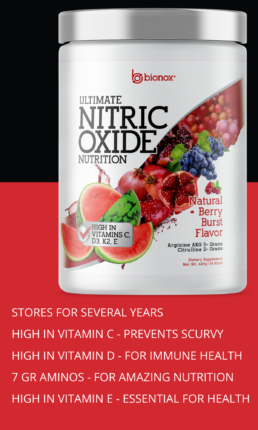
The Heart-Health Connection
A heart-healthy diet revolves around consuming foods rich in nitrates and antioxidants, which promote cardiovascular function and overall wellness. Nitric oxide, a compound our body produces with help from nitrates, plays a pivotal role in regulating blood pressure and enhancing blood flow, which is crucial for optimal heart health.
Understanding the Role of Nitrates in Heart Health: What are Nitrates Anyway?
Nitrates are compounds found naturally in certain vegetables like beetroot, arugula, and a few others and are converted into nitric oxide in the body via bacteria found in your mouth. Nitric oxide plays a crucial role in maintaining vascular, arterial, and heart health, as it helps to dilate blood vessels, improve blood flow, and reduce blood pressure, to name just a few benefits of this amazing compound. A diet rich in nitrates can, therefore, contribute significantly to improving cardiovascular health. Interesting and of note for this discussion, nitrates are sensitive to heat and can be depleted during cooking or prolonged storage. This makes it challenging to preserve their heart-healthy benefits, especially in emergency situations where access to fresh produce may be limited.
What can extend the life of nitrates in vegetables like Beets?
Adding vitamin C (ascorbic acid) can help preserve the nitrate content in vegetables like beets when they are stored for longer periods of time. Vitamin C plays a major role in preventing the conversion of nitrates to nitrites, which is especially important if you’re aiming to consume these vegetables for their nitrate content for potential health benefits, such as supporting heart health.
When nitrates turn into nitrites in the presence of certain enzymes and bacteria, you lose the potential cardiovascular benefits associated with nitrates. Nitrites, on their own, are not harmful and can even convert back to nitric oxide in the body under certain conditions. However, in the presence of proteins (like in some processed meats), nitrites can form nitrosamines, some of which have been implicated as potential carcinogens. Thus, there’s often a concern about nitrite levels in foods.
By adding vitamin C to preserved veggies, you are not only preserving the nitrate content but also reducing the potential for nitrosamine formation if those vegetables are consumed with protein sources. This is one reason why vitamin C (or erythorbic acid, a derivative of ascorbic acid) is often added to cured meats—it acts as a nitrosamine inhibitor.
Bionox and Ultimate Nitric Oxide Nutrition: A Lifeline for Your Heart
In times of crisis, having a reliable and effective supplement can make all the difference. Bionox’s Ultimate Nitric Oxide Nutrition (UNON) is precisely that. Packed with a potent blend of ingredients designed to boost nitric oxide levels in the body, UNON ensures that your cardiovascular system receives the support it needs, even when your diet might be lacking. With a shelf life of four years or more and efficacy that extends even beyond that, UNON is an indispensable part of any emergency prep kit.
Step-by-Step Guide to Heart Healthy Emergency Meal Prep
1. Planning and Selection of Ingredients: Start by listing down nitrate-rich foods such as beets, spinach, arugula, and celery. These should form the cornerstone of your meal prep plan. Remember, the goal is to preserve their nitrate content, so consider how you’ll store and prepare them.
2. Proper Storage Techniques: Invest in airtight containers and vacuum-sealed bags to store your ingredients. This prevents oxidation and helps retain the nitrates in the food. If you have access to refrigeration, use it. For longer-term storage, consider freezing portions of cooked or raw nitrate-rich foods.
3. Cooking and Preparation: Opt for cooking methods that preserve the integrity of nitrates. Steaming and roasting are preferable to boiling. If you must boil, try to incorporate the cooking water into your meal, as nitrates are water-soluble and can leach out during the cooking process.
4. Diversify Your Diet: Include a variety of heart-healthy foods in your meal prep. Focus on whole grains, lean proteins, and a range of fruits and vegetables to ensure a balanced diet. Remember, variety is key to covering all your nutritional bases.
5. Limit Processed Foods: Processed foods often contain high levels of sodium and unhealthy fats, which can negatively impact heart health. Aim to prepare whole, natural foods as much as possible, and be mindful of the ingredients in any packaged foods you might use.
6. Incorporate Healthy Fats: Include sources of omega-3 and monounsaturated fats in your diet, such as flaxseeds, walnuts, olive oil, and avocados. These fats are beneficial for heart health and provide a sustained source of energy.
7. Stay Hydrated: Ensure you have access to clean drinking water. Staying hydrated is crucial for maintaining blood volume and ensuring that your cardiovascular system functions optimally.
8. Make Use of Bionox’s Ultimate Nitric Oxide Nutrition: UNON is designed to be versatile and can be incorporated into a variety of meals or taken on its own. Including UNON in your emergency meal prep ensures that you are providing your body with the essential nutrients it needs to maintain cardiovascular health, even in challenging times. In times of stress, your blood pressure may spike massively, therefore necessitating even more the need for something like our UNON formula.
Final Thoughts
Preparing for emergencies is a responsible act, to say the least, and ensuring that your emergency meals are heart-healthy is a critical aspect of that preparation. By choosing the right heart-healthy ingredients, employing proper storage techniques and cooking methods, and incorporating a potent supplement like Bionox’s Ultimate Nitric Oxide Nutrition, you can ensure that your emergency meals are not just sustenance but a source of strength and health. Remember, your heart is at the core of your well-being, and taking steps to protect it, even in emergencies, is an investment in your future health and vitality.
Do Amino Acids Boost Nitric Oxide?
Do Amino Acids Boost Nitric Oxide? If you have heard about l-arginine or l-citrulline and their potential for elevating nitric oxide levels, you may have asked yourself that question.
Some amino acids do, in fact, help your body produce nitric oxide, some do not, and some may work for younger people and not as well as you age. Let’s dive into what Aminos help with Nitric Oxide and also what other things they can do.

L-Arginine
- Boosts Nitric Oxide? Yes.
- Health Benefits: L-Arginine is a precursor to the production of nitric oxide, making it critical for NO synthesis in your body. It also supports protein synthesis, wound healing, and immune function. It works best when combined with L-Citrulline. Together, they provide more of a nitric oxide boost than just one taken alone. There is so much information out there on arginine, it has literally hundreds of thousands of studies. It has been shown to boost nitric oxide time and again.
- Reference: NIH – Arginine
L-Citrulline
- Boosts Nitric Oxide? Yes.
- Health Benefits: L-Citrulline increases arginine levels in the body, which in turn helps increase NO production. This may seem counterintuitive and begs the question, “Why not just take L-Arginine?”. This is a great question and one that has been addressed by tons of recent research. The choice between L-arginine and L-citrulline isn’t about which one is “better,” but which one might be more effective for specific purposes due to their different metabolic pathways and absorption rates.
Here are some reasons why L-citrulline is different from L-arginine:
Better Absorption:
L-citrulline is absorbed more efficiently in the intestines than L-arginine typically. When you consume L-arginine, a significant portion can be broken down in the liver before it reaches systemic circulation and can be used by your body. L-citrulline bypasses this extensive first-pass metabolism in the liver, and once it is absorbed, part of it is converted to L-arginine in the kidneys.
Sustained Increase in Blood Arginine Levels: The conversion of L-citrulline to L-arginine in the kidneys results in a more sustained increase in blood arginine levels compared to consuming L-arginine directly. This prolonged elevation could produce more consistent nitric oxide over time for many individuals.
Lowered Risk of Gastrointestinal Distress: L-arginine can cause gastrointestinal distress at high doses. This is not the case for equivalent doses of L-citrulline. Some forms of Arginine, however, are easier to digest than others.
Synergistic Effects with Other Metabolites: L-citrulline is part of the urea cycle, and its metabolism might have added benefits due to the other metabolites in this cycle, like L-ornithine. So again, it still produces L-Arginine in your system, but it has a few extra goodies in it.
Safety and Tolerability: L-citrulline, especially when derived from natural sources like watermelon, can be a safer and more tolerable option for some people. ( Yup, we use Watermelon in our products! )
Other Potential Benefits: There’s ongoing research into L-citrulline’s potential advantages beyond just nitric oxide production, including muscle protein synthesis and ammonia detoxification, immunity, and so much more. It may enhance exercise tolerance in people with certain cardiovascular conditions, support the heat, veins, and arteries, and a long list of other potential benefits. - Reference: Citrulline and Exercise Performance
L-Lysine
- Boosts Nitric Oxide? No.
- Health Benefits: L-lysine is vital for protein synthesis, normal hormone production, and calcium absorption. It’s also often used to prevent and treat cold sores (herpes simplex labialis).
- Reference: NIH – Lysine
Taurine
- Boosts Nitric Oxide? Not directly.
- Health Benefits: Taurine has several functions, including maintaining proper hydration and electrolyte balance in cells, forming bile salts, and supporting the general function of the central nervous system and eyes. Taurine supports heart health by helping to regulate blood pressure and heart rate. It may help reduce the risk of cardiovascular disease by possibly improving the levels of blood lipids and reducing systemic inflammation.
- Reference: Taurine: A “very essential” amino acid
L-Tyrosine
- Boosts Nitric Oxide? No.
- Health Benefits: L-Tyrosine is important for producing neurotransmitters that regulate mood, such as dopamine, norepinephrine, and epinephrine. It is a common ingredient in many nootropic supplements and some energy drinks. These neurotransmitters that L-tyrosine helps produce, especially epinephrine and norepinephrine, are essential for the body’s stress response. During stress, these neurotransmitters are released to potentially help prepare the body to respond, leading to increased heart rate, blood flow to essential organs, and alertness. Proper synthesis and function of these neurotransmitters are critical for an appropriate stress response. Norepinephrine plays a role in constricting blood vessels, which can elevate blood pressure. Individuals with certain conditions that involve an imbalance in neurotransmitter production could benefit from L-tyrosine supplementation to help regulate blood pressure. However, it’s also worth noting that excessive norepinephrine can lead to hypertension, so it’s a delicate balance.
- Reference: NIH – Tyrosine
L-Glutamine
- Boosts Nitric Oxide? No.
- Health Benefits: Glutamine is the most abundant amino acid in the bloodstream and serves multiple vital functions in the body. L-glutamine supports gut health, immune function, and wound healing. It’s also a vital nutrient for rapidly dividing cells, including those of the gut and immune system. Even though it does not produce nitric oxide, glutamine is incredibly useful for supporting the body’s creation of Glutathione, an essential antioxidant.Glutathione (GSH) is a tripeptide, meaning it is composed of three amino acids: cysteine, glutamate (derived from glutamine), and glycine. The synthesis of glutathione in the body occurs in two main steps:
- First Step: The enzyme γ-glutamylcysteine synthetase catalyzes the binding of cysteine to glutamate to form γ-glutamylcysteine. This step is rate-limiting, meaning it’s the slowest step in the synthesis process and often determines the overall rate of glutathione production.
- Second Step: The enzyme glutathione synthetase adds glycine to the γ-glutamylcysteine molecule, forming glutathione.
- Reference: Glutamine: Metabolism and Immune Function, Supplementation and Clinical Translation
L-Leucine
- Boosts Nitric Oxide? No.
- Health Benefits: L-Leucine is a branched-chain amino acid (BCAA) that is important for protein synthesis and muscle repair. It also helps regulate blood sugar levels.
- Reference: Leucine as a pharmaconutrient to prevent and treat sarcopenia and type 2 diabetes
L-Isoleucine
- Boosts Nitric Oxide? No.
- Health Benefits: Another BCAA, L-Isoleucine is crucial for hemoglobin production and might help with glucose consumption during physical activity.Many products use L-Isoleucine, especially within the sports nutrition and bodybuilding sectors. It’s a common ingredient in protein powders, amino acid supplements, and many recovery drinks. The use of L-Isoleucine, alongside the other BCAAs, is touted for its potential to enhance muscle recovery, reduce muscle soreness, and improve athletic performance in healthy individuals. This stems from BCAAs’ role in muscle protein synthesis and energy production during exercise and has been widely researched.Beyond athletic performance use, L-Isoleucine has several potential health benefits that may be of interest. Firstly, there’s some evidence that it may support blood sugar regulation. L-isoleucine can increase the uptake of glucose into muscle cells and improve glucose metabolism, which can be particularly beneficial after periods of physical activity when muscle cells are more receptive to glucose. By supporting glucose uptake and utilization, L-Isoleucine might play a role in maintaining stable blood sugar levels.L-isoleucine can also promote wound healing. Amino acids are the building blocks of proteins, and proteins, such as collagen, are essential for the repair and regeneration of tissues. Therefore, having an adequate supply of essential amino acids, including L-Isoleucine, can support the body’s natural healing processes.Additionally, as with other amino acids, L-Isoleucine is involved in synthesizing various proteins and enzymes critical for numerous physiological processes. This means that an adequate intake is vital for overall health, ensuring that the body has the necessary components to carry out its daily functions efficiently.While L-isoleucine is popularly recognized for its role in sports nutrition, its impact on health is multifaceted. L-Isoleucine plays an integral role in maintaining health and well-being, from supporting glucose metabolism to promoting tissue repair and being a foundational component for protein synthesis.
- Reference: Amino Acid Properties and Consequences of Substitutions
L-Valine
- Boosts Nitric Oxide? No.
- Health Benefits: As the third BCAA, L-Valine promotes muscle growth and tissue repair. It’s also involved in energy production.
- Reference: BCAAs and Brain Function
L-Methionine
- Boosts Nitric Oxide? No.
- Health Benefits: L-methionine is essential for tissue growth, absorption of minerals, and the production of essential molecules like taurine, L-cysteine, and L-carnitine.
- Reference: Methionine metabolism: Major pathways and enzymes involved and strategies for control and diversification

Do Amino Acids Boost Nitric Oxide?
The answer is yes; some do, as can be seen above. With Argnine and Citrulline both being important. There are a few important things to note: how to take them, when, and in what ratios.
Do Amino Acids Boost Nitric Oxide when taken in small dosages? Will the typical $29.99 so-called Nitric Oxide booster really produce nitric oxide in my body?
The answer is yes, but the real question is how long do they produce it? Therein lies the issue. Your cheap 1000mg arginine product or 500mg citrulline product will produce nitric oxide in your system for a very short period of time, producing very minimal health or energetic effects. Most studies indicate that around 5 grams of arginine and 2 grams of citrulline are ideal, and they must be taken together for maximum effect. That is roughly a 2:1 ratio.
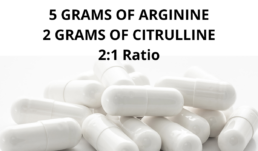
Where do Amino Acids Come From?
Amino acids used in supplements and for food items and human consumption are typically manufactured via two main methods: extraction from natural sources and bacterial or yeast fermentation. Both methods have their own advantages and special considerations. Let’s explore these methods and address the concerns of purity, cleanliness, and potential contaminants. If you are considering using amino acids, knowing where they come from, how they are made, and safety concerns should help you make a better decision on what kinds to use and from what source.
- Extraction from Natural Sources:
Some amino acids are derived directly from protein-rich natural sources like animal tissues or certain plants. The raw materials used in this process are subjected to something called ‘hydrolysis,’ which is the process of using acid or enzymes to break down the proteins into individual amino acids. After this is complete, various purification processes are performed to obtain the specific amino acids in their purest form. - Bacterial or Yeast Fermentation:
For many different types of amino acids, especially those that are labeled as vegan or vegetarian, bacterial or yeast fermentation is the primary method of production. Some types of aminos are not yet available via this method.The bacterial and yeast fermentation processes can produce a wide range of amino acids. However, the capability to produce many types of specific amino acids often depends on the microbial strain used and its metabolic pathways. While many amino acids can be synthesized efficiently using this microbial fermentation process, some might be more challenging or possibly less economically viable to produce in this manner compared to extraction or chemical synthesis.Historically speaking, amino acids such as L-methionine, L-phenylalanine, and L-tryptophan have been more challenging to produce in high yields using microbial fermentation. However, today’s advances in metabolic engineering and biotechnology have enabled improved manufacturing and production of these amino acids in recent years.It’s also worth noting that certain specialized amino acids or derivatives, which might be used for very specific health applications or research purposes, might be synthesized using other methods if fermentation isn’t feasible or efficient.Currently, the list of amino acids unavailable via microbial fermentation is continuously shrinking as advances in biotechnology, genetic engineering, and metabolic pathway research enable the modification of microorganisms to produce an ever-expanding array of compounds. If there’s a specific amino acid or set of amino acids you’re curious about, it would be best to look into the current production methods, as they can evolve over time.In this method, specific strains of bacteria or yeast that have the ability to produce high yields of the desired amino acid are grown in large fermentation tanks. Once the fermentation process is complete, the amino acid is extracted and purified from the fermentation broth.
Purity and Cleanliness:
Most reputable supplement manufacturers prioritize the purity and cleanliness of their products, but certainly not all, as there are many reports of shady companies with cheap Chinese-made ingredients with no purity testing. After a clean manufacturing facility creates a batch of aminos, the amino acids undergo various purification processes to remove any residual solvents, by-products, or contaminants.
MAKE SURE THEY ARE GMP
Good Manufacturing Practices (GMP) standards are often followed by quality supplement manufacturers, which ensure that amino acid-based products are produced consistently and meet quality standards. If you want to ensure your amino acids are clean, look for GMP-certified products.
If a product is GMP certified, it normally means the manufacturer has demonstrated a strong regulatory commitment and compliance with international GMP standards such as purity, cleanliness, and transparency.
Potential Contaminants:
Like all manufactured products, there’s a potential for contaminants if quality control measures aren’t stringent. These contaminants could include residual solvents from the extraction process, heavy metals, or impurities from raw materials, in other words, some really nasty stuff! Some low-quality or improperly stored amino acids might also be prone to bacterial or fungal contamination. So, more than just GMP is needed. You should look for products that have been tested and come with what is called a COA.
Consumer Tips:
For consumers, it’s always highly recommended to:
- Purchase your supplements from reputable brands and sources. Products on Amazon and from companies like WalMart may be of lower quality as they are marketed and priced for low quality and lowest price.
- Look for third-party testing or certification. This means an independent laboratory has verified the product’s purity and potency.
- Check for product reviews and feedback. While it’s true most product reviews on websites like Amazon have a huge amount of fake and paid-for information, some reviews may be of value.
In summary, while amino acids manufactured for supplements are generally clean, pure, and safe for consumption, the quality can vary based on the manufacturer and the source. Always do your due diligence and opt for high-quality products to ensure you are getting a safe and effective product.
Are nitric oxide supplements worth it?
Are nitric oxide supplements worth it? If you have investigated the use of nitric oxide supplements and found multiple options, each with confusing and differing opinions and prices, you may have asked yourself this question. Perhaps you are just beginning your investigation on nitric oxide for a health issue like high blood pressure, circulation, ed, or a host of other issues. In any case this article will help you to understand what nitric oxide can do for your health, what it can’t do and what products and ingredients are best for your situation.
What is Nitric Oxide?
I am going to assume you already know something about nitric oxide if you are asking about its worth and effectiveness. If you don’t it’s enough to say for now, it’s a substance produced in your body that opens your veins and arteries. The benefits of increased circulation to multiple organ systems is massive and reaches to almost all known organ systems and body parts. If you want to learn more about what nitric oxide is click here.
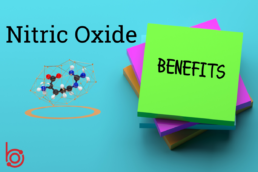
What Are The Benefits Of Nitric Oxide?
Nitric oxide plays a vital role in many of the body’s physiological processes an d as mentioned earlier, it opens up your arteries and veins. This opening is going to cause massive changes, especially for those who are older and have circulatory blockages.. Here are the top 10 benefits associated with nitric oxide supplementation for health:
- Enhanced Vasodilation: Nitric oxide causes blood vessels to dilate or open, improving blood flow throughout the body and bringing more nutrients to every cell. Delivering oxygen and nutrients more effectively leads to better health, energy and recovery. It’s important to not just think about the heart here. Think brain, lungs, reproductive systems, everything! What organ does not benefit from more blood flow?
- Improved Athletic Performance: By increasing blood flow, nitric oxide can boost exercise performance and decrease muscle soreness. More blood means more food for the muscle, faster recovery and more power. Bodybuilders have used no for years for these reasons and to increase their pumped looking veins needed to win competitions!
- Lower Blood Pressure: Through its vasodilatory effects ( opening your veins ), nitric oxide can help reduce blood pressure, which is essential for cardiovascular health. High blood pressure plus high inflammation are a recipe for atherosclerosis and worse.
- Enhanced Brain Function: NO can increase blood flow to the brain, potentially improving cognitive functions, memory, etc.
- Improved Immune System: Nitric oxide can bolster the immune system by defending against bacteria and reducing the growth of bad stuff like tumors and more. The mechanisms used here are multiple and this gets complex. One way this is done is by disruption of Iron metabolism. Many bacterial species require iron to live and grow. Nitric oxide can bind to iron-sulfur clusters in bacterial enzymes, disrupting their normal functions. This not only interferes with bacterial metabolism but also deprives bacteria of the essential iron they need to grow.
- Alleviation of Erectile Dysfunction: By promoting blood flow, nitric oxide can help treat erectile dysfunction. This is fairly straightforward. An erection needs blood and if you have impaired blood flow, then it’s a show stopper.
- Support Digestive Tract Health: Nitric oxide helps relax the muscles in the gastrointestinal tract, assisting in processes like moving food through the stomach and intestines. Amazing to think it can even help digestion, a little touted effect of no!
- Decreased Muscle Soreness: By increasing blood flow and nutrient delivery, nitric oxide may help reduce muscle soreness after a hard day at the gym or sporting event.
- Anti-inflammatory Properties: Nitric oxide has shown potential in reducing inflammation, making it beneficial for various conditions like atherosclerosis and so much more. Inflammation is the cause of so many diseases, making no so much more important!
- Increased Lifespan: Some studies suggest that nitric oxide can extend the lifespan by reducing oxidative stress. If you want to look and feel younger then this is exactly what you want!
- Reference: Nisoli E, et al. Mitochondrial biogenesis in mammals: the role of endogenous nitric oxide. 2003.

Are Nitric Oxide Supplements Worth It?
So the answer depends on several factors here. One being effectiveness. Here is a list of the top 3 most common ingredients used to boost no, and later will will go into effectiveness and value.
- L-Arginine: Often considered by many as the foundational ingredient in most nitric oxide supplements, L-arginine is an amino acid that serves as a direct precursor to the nitric oxide molecule. When introduced into the body orally, it undergoes a conversion process, turning into nitric oxide, thus aiding in the dilation of blood vessels and promoting improved circulation. The time it takes to do is is different than citrulline so taking arginine and citrulline together is more powerful as it gives you a time released effect. When one is starting to work the other is stopping.
- L-Citrulline: This is another amino acid that plays a pivotal role in nitric oxide production as mentioned above. What makes L-citrulline especially interesting is its indirect approach. Once consumed, it bypasses the liver and is transformed into L-arginine in the kidneys. As a result, this can lead to elevated levels of L-arginine in the blood, contributing to enhanced nitric oxide production. Again this is on a different time line as opposed to arginine so taking them both give you more no boosting aminos and tends to work longer.
- Beetroot Extract: Mother Nature’s very own nitric oxide booster! Beetroots come packed with dietary nitrates, compounds that our bodies can convert into nitric oxide. Nitrates like the aforementioned amino acids also can create nitric oxide. It works via different mechanisms mostly involving bacteria in your mouth and stomach.
Which type of Nitric Oxide Booster Is More Effective?
The answer short answer is they all work, but they work much better if you use them all! Some people will do better with beets, and some with the arginine and citrulline combination. Any arginine citrulline combination should include antioxidants and vitamin d for maximum effectiveness as antioxidants help extent the life of the no molecule. If you are considering using a nitric oxide supplement, it’s a good idea to try them both. Beets or Aminos.
Are nitric oxide supplements worth it?
If you are buying a cheap Amino Acid only product, or beetroot with no standardized nitrates then probably no. It’s not worth the money. When you purchase beetroot, make sure it has at least 100mg of nitrates. If you buy a really good arginine and citrulline based formula with all the needed antioxidants it’s going to cost over $50 for the good stuff. If the formula is high quality it is worth it to buy a nitric oxide supplement and going to have a high impact on your health and energy.
So in summary, nitric oxide supplements do work, you just need to buy quality products, look for nitrate count on beets and if you use aminos, make sure they contain both arginine and citrulline and a host of antioxidants and possible supporting herbs as well. Using a good no boosting will save you thousands of dollars in medical bills and lost work, or quite possible even you life.
Debunking the Myth: Does L-Arginine Work?
Does L-Arginine Work?
In the world of health supplements and nitric oxide products, few amino acids have garnered as much attention as L-Arginine, particularly for its role in producing nitric oxide (NO), a molecule vital for vascular health.
However, as with many popular supplements, L-Arginine has seen its fair share of detractors. Some companies, possibly driven by motives to promote their own products or strategies, claim that L-Arginine does not work. Let’s dive into these assertions, understand their basis, and examine the broader picture.
Does L-Arginine Work? Why Do Some Claim L-Arginine Doesn’t Work?
- Selective Interpretation of Research: Some of the most vocal criticisms stem from some studies suggesting that L-Arginine supplementation may not always result in improved NO production, especially in those with compromised endothelial function. These very limited studies sometimes conclude that the Nitric Oxide Synthase (NOS) enzyme, responsible for converting L-Arginine to NO, might not operate efficiently in everyone. It is important to keep in mind there are almost 100,000 studies showing arginine roles in promoting health and supporting nitric oxide. Yet only a handful of studies show no effects or negative effects.
- Marketing Motives: It’s no secret that the health industry is competitive. Companies vying for a larger market share of the NO-boosting segment might downplay the benefits of L-Arginine to promote alternative products, like beetroot extracts. Everyone is looking for a unique angle and message; the goal is to sell you their unique product.
- Misunderstanding of Mechanisms: The process of NO production is complex. It’s not just about consuming L-Arginine; other factors like oxidative stress, the presence of heavy metals, and overall health can impact the efficiency of the NOS enzyme.
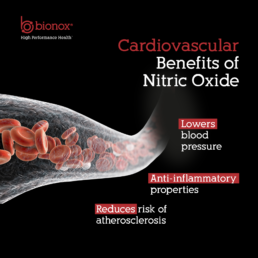
Why L-Arginine DOES Work: Looking Beyond the Myths
- Overwhelming Positive Research: While there are a few studies pointing to the limitations of L-Arginine, there are thousands more that highlight its benefits. A vast body of research has showcased the efficacy of L-Arginine in boosting nitric oxide levels, supporting cardiovascular health, aiding muscle growth, and so much more!
- Understanding the Body’s Complexity: The body is not a one-size-fits-all mechanism. Just because L-Arginine might not work for a specific subset of people under particular conditions does not render it ineffective for everyone. Individual biochemistry, diet, lifestyle, and even genetics can influence how one responds to L-Arginine supplementation.
- Supporting Ingredients and Strategies: Often, the effectiveness of L-Arginine can be enhanced when combined with other supporting ingredients. For instance, antioxidants can mitigate oxidative stress, improving the environment in which the NOS enzyme functions. Similarly, detoxification agents can remove heavy metals that might hinder NO production. Vitamin D plays a huge role in nitric oxide production as well.
Understanding the NOS Pathway and the Logic of Detoxification Over Beet Supplementation
The Nitric Oxide Synthase (NOS) pathway is crucial in nitric oxide (NO) production. As we age, it’s believed, as mentioned above, that the efficiency of the NOS pathway diminishes, potentially leading to a reduction in NO production. In light of this fact for many, two primary strategies are often proposed: direct nitrate supplementation through beetroot products and detoxification of the NOS pathway.
Let’s explore why detoxifying the NOS pathway might be a more logical approach and why fixing the problem is better than just using what works under a broken system.
1. Addressing the Root Cause vs. Symptom Treatment:
- Beetroot Approach: Beets are veggies that are rich in dietary nitrates, which the body can convert into nitric oxide through a different pathway, bypassing the NOS enzyme. This is a direct supplementation approach. While it can raise NO levels, it does not address the inherent dysfunction within the NOS pathway. Thus, the root cause of the diminished NO production due to a compromised NOS pathway remains unaddressed.
- Detoxification Approach: By focusing on detoxifying the NOS pathway, you can restore its original function. Over time, various factors such as oxidative stress, accumulation of heavy metals, and other toxins can impair the NOS pathway. Detoxifying can potentially remove these hindrances, allowing the NOS enzyme to function optimally. Why not restore your body’s ability to convert arginine into nitric oxide? It makes so much more sense to treat the entire system and not just bypass it.
2. Comprehensive Health Benefits of Detoxification:
Beyond just improving the NOS pathway, detoxification offers many health benefits. It can lead to increased energy, improved cognitive function, reduced risk of chronic diseases, and an immune system boost. In contrast, while beet supplementation boosts NO levels, it might not offer these broader health benefits associated with detoxification.
3. Variability in Response to Beets:
Not everyone may benefit equally from beet supplementation. Factors such as gut flora composition and oral hygiene can influence the conversion of dietary nitrates from beets to NO. On the other hand, detoxifying the NOS pathway could possibly provide more consistent benefits across different types of individuals, as the emphasis is on enhancing a natural physiological process.
4. Long-Term Sustainability:
Detoxification can lead to sustainable improvements in the NOS pathway, potentially providing you with longer-lasting benefits. Conversely, the effects of beet supplementation are often transient in nature. Once supplementation stops, the boosted NO levels might decline, especially if a person’s NOS pathway remains compromised.
In Conclusion
Does L-Arginine Work? Yes, it certainly does and has been shown to work repeatedly in study after study. While beetroot supplementation can certainly be a part of your personal strategy to boost your nitric oxide levels, especially if you have significant NOS impairment, it’s essential to recognize the potential limitations of beetroot and nitrates. Detoxifying and revitalizing the NOS pathway addresses the issue at its core, aiming to restore the body’s natural ability to produce nitric oxide. This holistic approach boosts NO levels and improves overall well-being and long-term health.
Zeolite Supplements
Zeolite Supplements – An Unparalleled Detox Experience
Zeolite has always been a subject of intrigue and study, from ancient Rome’s aqueducts to modern wellness enthusiasts.
Because of its unique molecular structure, this natural wonder promises a range of health benefits that few supplements can match.
Zeolite Through the Ages
Zeolite’s journey began centuries ago, with ancient civilizations holding it in high regard not just for its health benefits but also because of its reactions to heat and common use in water purification. Over the millennia, as our understanding deepened, Zeolite made the transition from construction sites to health stores.
Historically, the Romans are celebrated for their advanced engineering, especially in the construction of aqueducts and other infrastructural works. They utilized these naturally occurring, porous minerals, zeolites, primarily for water purification. Zeolites can exchange certain positively charged ions (cations) thanks to their microporous structures. This ion exchange capability allowed them to soften water.
More specifically, the Romans purified their water using a type of zeolite called “chabazite.” They incorporated this mineral into their aqueduct systems, where the passing water exchanged its calcium for sodium in the zeolite, softening the water. This process was particularly beneficial in preventing calcium buildup in their complex aqueduct systems. The advanced nature of their practices is remarkable.
The Science Behind the Magic
Beneath its gritty exterior, Zeolite boasts a lattice-like structure. Because of this, it has an uncanny ability to trap and eliminate unwanted substances. Thus explaining its growing popularity as a detoxifying agent.
Some studies suggest that it might even have antibacterial properties due to its high cation exchange capacity, which can affect the environment where bacteria live, making it less conducive for their growth.
Why Zeolite Supplements?
Toxin Terminator
Zeolites have a keen sense for toxins. This is because they bind, trap, and aid in expelling them from our system.
Antioxidant Boost
With the world becoming an oxidative battleground, Zeolite is a sentinel, combating oxidative stress.
Balancing Act
Our body’s pH swings with our diet and stress. Zeolites help restore the balance, promoting an alkaline environment.
Precautions and Pairings
Kidney ailments? Approach Zeolite with caution. If you are considering taking a zeolite supplement, especially with kidney issues, you must be aware of its effects and any potential interactions with other ingredients.
Zeolites are renowned for their ability to adsorb. They are know for trapping and removing various substances. There are many substances, including heavy metals and toxins, that it can remove from the body. The adsorption process binds these substances to the zeolite particles. After binding, the body needs to eliminate these substances, a role the kidneys play.
The potential concerns related to kidney function when taking zeolite include:
- Increased Load on Kidneys: As zeolite binds to toxins and heavy metals, the kidneys work to filter and excrete these compounds. An increased load of these bound materials may add extra stress to the kidneys, especially if taken in large amounts or over extended periods.
- Reabsorption: There’s a possibility that not all bound toxins will be excreted efficiently. Some might be reabsorbed into the bloodstream, causing the kidneys to work harder to remove them a second time.
- Crystalline Structure: Some believe that the crystalline structure of zeolites could potentially cause harm if the particles are not small enough. Larger particles might not be easily processed and excreted by the kidneys, though most commercially available zeolite supplements are micronized or broken down to ensure safe passage through the body.
- Mineral Imbalance: Zeolites don’t just bind to “bad” substances. They can also bind to essential minerals, potentially leading to mineral imbalances. If important minerals like potassium or magnesium are depleted, it can affect kidney function.
- Potential Contamination: Natural zeolites can sometimes contain other metals or compounds. If not properly processed and purified, these contaminants might introduce additional substances for the kidneys to filter.
Considering the above possible issues, we developed Chelanox to provide a gentle flushing of the kidneys and a potent dose of Zeolite. Chelanox by Bionox contains not just zeolite, but a blend of other ingredients, some of which may benefit the kidneys, making it safe to take with Zeolite.
Breakdown Of Ingredients
- EDTA (Calcium Disodium): Often used in chelation therapy and for detoxing. EDTA helps bind heavy metals in the bloodstream, preparing them for excretion via the urine. Removing these toxins gives the kidneys potential relief, as they won’t need to filter these harmful substances.
- Chlorella Algae: Chlorella shows detoxifying properties, helping to remove heavy metals and other toxins from the body. This might support kidney function by reducing the toxins the kidneys have to handle.
- Uva Ursi Leaf Powder: Traditionally, Uva Ursi has been used as a natural remedy for urinary tract infections. It possesses diuretic properties, which may help cleanse the kidneys and urinary system.
- Milk Thistle Seed Powder: Milk thistle supports liver function, which in turn can aid the kidneys. When the liver functions optimally, it processes toxins more effectively, so fewer toxins reach the kidneys.
- NAC (N-Acetyl Cysteine): An antioxidant that can help replenish intracellular levels of the natural antioxidant glutathione. Glutathione assists in detoxification processes, potentially reducing the strain on the kidneys.
- Alpha Lipoic Acid: This is both water- and fat-soluble, meaning it can work throughout the body. It helps with heavy metal detoxification and supports both liver and kidney function.
By providing a combination of ingredients that support detoxification processes and the health of the liver and kidneys, Chelanox aims to balance the potent adsorption qualities of zeolite. However, it’s vital that anyone, especially those with kidney concerns, consults with a healthcare professional before starting any new supplement like Chelanox.
Chelanox: Zeolite’s Perfect Partner
While Zeolite is impressive on its own, synergy with products like Chelanox elevates its potency. Consider Chelanox as Zeolite 2.0 – enhanced with EDTA, Chlorella, and Cilantro extract. This alliance fortifies detoxification, paving the way for a more robust immune system and a healthier heart. It works amazingly well in combination with Nitric Oxide Products.
Nitric Oxide & Zeolite
From the depths of the earth, zeolite supplements emerge as a beacon for those in pursuit of detoxification. Their combination with products like Chelanox enhances these detox benefits. Yet, their impact extends beyond detoxification to include another critical element: Nitric Oxide (NO).
Nitric Oxide plays a crucial role in supporting various vital body functions. These include vasodilation (the expansion of blood vessels), blood pressure regulation, circulation improvement, and the modulation of immune responses. Produced through the Nitric Oxide Synthase (NOS) pathway, NO is akin to the circulatory system, but for distributing nitric oxide instead of blood. However, this pathway can be hindered by toxins and heavy metals, affecting NO production.
Here’s how Chelanox with Zeolite, when taken in conjunction with a nitric oxide supplement, can be a powerful combination:
- Detoxification of the NOS Pathway: Heavy metals and other toxins can negatively affect the NOS pathway. For instance, heavy metals like lead, cadmium, and mercury can disrupt enzymatic activities essential for producing nitric oxide. Chelanox, with its blend of detoxifying ingredients like EDTA, chlorella, and cilantro extract, can help chelate and remove these heavy metals. This assures that the NOS pathway functions optimally.
- Enhancing Blood Flow: The primary function of nitric oxide is to promote vasodilation and blood flow. The NOS pathway operates efficiently, ensuring it keeps heavy metals and toxins at bay. By using Chelanox with Zeolite, you support better blood flow and improved delivery of nutrients so oxygen gets delivered to more tissues.
- Improving Nutrient Absorption: Chelanox plays a vital role in gut health and overall digestive function. It does so by chelating and removing toxins and heavy metals from the body. This can lead to better absorption of essential nutrients, including those from nitric oxide supplements.
- Supporting Kidney Function: The kidneys must carefully process zeolites, an ingredient in Chelanox, as previously mentioned. Ingredients in Chelanox, such as milk thistle, play a crucial role in supporting liver function. This support indirectly benefits kidney health. Proper kidney function ensures improved blood pressure regulation, because of the enhancing effects of nitric oxide.
- Synergistic Immune Support: While nitric oxide plays a role in immune modulation, toxins, and heavy metals can impede the immune system. By detoxifying the body using Chelanox, the immune system can operate more effectively. It helps by synergistically working with nitric oxide to combat pathogens and inflammation.
- Optimized Cardiovascular Health: One of the major benefits of nitric oxide is its positive effect on cardiovascular health. Chelanox removes heavy metal impediments. This allows the heart and vascular system to benefit. Nitric oxide supplementation then improves cardiovascular function.
Combining Chelanox with a nitric oxide supplement ensures better health. It helps detoxifying the body and optimizes the pathways and systems that nitric oxide uses. By keeping the NOS pathway clear of impediments, the body can effectively utilize nitric oxide for various benefits, from improved circulation to enhanced immune function.






